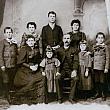James Bemis Page, "The Stone Man"
by Michael J. Page
James Bemis Page, Grand Rapids native, and Civil War veteran, was born to Jane E. Soper and Loren M. Page, December 1, 1846, in the Village of Grand Rapids, Michigan. Four years later, in 1850, the City of Grand Rapids was formally incorporated. The family lived in a simple wood frame, two-story house located at 556 College Ave. (pre-1912 address).
It is believed that James, the oldest of eight (8) siblings, was given the middle name of Bemis to honor Cyrus C. Bemis, a friend of his father Loren. Cyrus and Loren were Grand Rapids pioneers and early furniture makers, specializing in chairs.
In March 1863, at the tender age of 16 years, James enlisted in the U.S. Army, Michigan 1st Regiment Light Artillery, Battery L. James and four of his younger brothers served the Union during the “Slaveholders Rebellion”.
“James B. Page was a fine young man –
He went into the artillery;
He served his time with all the rest,
To keep his country free.”
His brother, Charles F. Page, died in Virginia at the Battle of the Wilderness, in 1864. At the war’s end, in 1865, James and his three remaining brothers returned to Grand Rapids. James found work as a laborer and painter. In 1870, he married Johanna E. Cummings in St. Andrew’s Catholic Church, a building constructed of stone quarried from the Grand River, located at the southeast corner of Monroe St. and Ottawa Ave. Rev. James C. Pulcher officiated.
By 1871, James was working as a teamster, driving teams of horses that pulled wagonloads of products to local businesses, hotels, and building sites. Later, several Grand Rapids City Directories list James B. Page as a stone contractor. He traveled Kent, Ottawa and Ionia counties looking for large boulders to be used in the foundations of local homes, churches and office buildings. When his search was successful, he freighted the boulders back to town aboard his steamboat, Matilda, and an attached scow. He used his ‘stone wagon’ to haul the boulders from his boat to the building sites. The wagon, big and long, low-built to the ground, was pulled by draft horses. It should be noted that draft horses are very large with muscular builds, bred for hard tasks like plowing fields and hauling heavy loads. His stone yard was located on the present site of the Kent County Road Commission, 1500 Scribner Ave. NW. James, his wife and children lived across the street at 1443 Scribner Ave. NW. It was here in a barn that he stored his stone wagon and kept his draft horses.
In 1874 - 1875, at age twenty-eight, James Page became involved in one of his many major building projects, leading him to become known as “The Stone Man”. During the previous winter, the property occupied by St. Andrew’s Church was sold to Moses D. Aldrich. The stone of the old church was used for the foundations of the present edifice. James hauled the stone from the Monroe St. and Ottawa Ave church site to the new site at Sheldon Ave. and Maple St. Because the new church was larger than its predecessor, it is believed he provided additional foundation stone as needed.
One hundred five (105) years after the foundation stones were laid for what would become the Cathedral of St. Andrew, Thomas P. Page was ordained a Catholic Priest in the very church that his great grandfather helped construct. June 16, 1979 was a proud day for the Page family and many friends and parishioners of St. Alphonsus Church, his home parish.
1884, James provided the foundation stone for the residence of Col. E. Crofton Fox and Charles Fox at 455 Cherry St. SE. The building is known as the Fox Castle and is a landmark in the Heritage Hill Historic District. When construction of the new City Hall began in May 1885, James provided foundation boulders. The cornerstone was laid in September 1885 and the construction was completed in 1888. Unfortunately, the building was demolished in 1969, a victim of “urban renewal”. Other buildings with James B. Page foundations: The original Michigan Soldier’s Home (now Grand Rapids Home for Veterans) and Sacred Heart Catholic Church.
James and his wife Johanna had nine (9) children between the years 1872 and 1888. Two children died before reaching the age of five. The surviving children all received good educations and went on to live well into their 70s and 80s … and one daughter lived until age 92. All but two remained in the Grand Rapids area.
When James B. Page died in 1928 at the age of 82, he left behind many sturdy foundations and buildings that serve to this day as monuments to “The Stone Man”.
Sources:
- Mortal Refrains, The Complete Collected Poems, Prose and Songs of Julia A. Moore—The Sweet Singer of Michigan, Thomas J. Riedlinger, 1998.
- History of the City of Grand Rapids, Michigan, Albert Baxter, 1891.
- Grand Rapids City Directories – Grand Rapids Public Library, Main Branch.
- The Story of Grand Rapids, Z.Z. Lydens, 1966.
- Military Pension Records for James B. Page, National Archives and Records Administration.
- Kent County (MI) Clerk’s Office - Marriage Records, Book 1, Page 256.
- United States Federal Census for the years 1850, 1860, 1880, 1900, 1910 & 1920.
- 1870 State of Michigan Census; www.hal.state.mi.us/1870census/
- ‘The Stone Man’ is a Part of History, by Arn Shackelford – The Grand Rapids Press, July 27, 1976.
- Record of Service of Michigan Volunteers in the Civil War, 1st Michigan Light Artillery; Grand Rapids Public Library – Main Branch.

 facebook
facebook